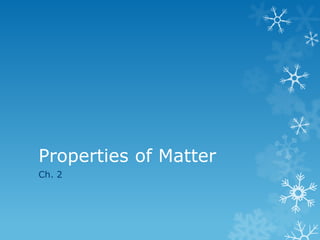
PROPERTIES OF MATTER.pdf
- 2. Quick Review Matter is anything that: a) has mass, and b) takes up space Mass = a measure of the amount of ―stuff‖ (or material) the object contains (don’t confuse this with weight, a measure of gravity) Volume = a measure of the space occupied by the object
- 3. States of Matter 1) Solid- matter that can not flow (definite shape) and has definite volume. 2) Liquid- definite volume but takes the shape of its container (flows). 3) Gas- a substance without definite volume or shape and can flow. Vapor- a substance that is currently a gas, but normally is a liquid or solid at room temperature. (Which is correct: ―water gas‖, or ―water vapor‖?) 4) Plasma- Ionized gas that contains positive ions and electrons
- 4. Drawing the States of Matter Solid Liquid Gas
- 5. States of Matter Solid Liquid Gas Definite Volume? YES YES NO Definite Shape? YES NO NO Result of a Temperature Increase? Small Expansion Small Expansion Large Expansion Will it Compress? NO NO YES
- 6. The 6 Phase Changes 1.Melting: Solid to Liquid 2.Freezing: Liquid to Solid 3.Evaporation: Liquid to Gas 4.Condensation: Gas to Liquid 5.Sublimation: Solid to Gas 6.Deposition: Gas to Solid
- 7. Describing Matter Properties used to describe matter can be classified as: 1) Extensive – depends on the amount of matter in the sample - Mass, volume, calories are examples 2) Intensive – depends on the type of matter, not the amount present - Hardness, Boiling Point
- 8. Is Density Intensive or Extensive?
- 9. Properties Words that describe matter (adjectives) Physical Properties- a property that can be observed and measured without changing the material’s composition. Examples- color, hardness, m.p., b.p.
- 10. Properties Chemical Properties- a property that can only be observed by changing the composition of the material. Examples- ability to burn, decompose, ferment, react with, etc.
- 11. Physical Change Physical change will change the visible appearance, without changing the composition of the material. Can be reversible, or irreversible Boil, melt, cut, bend, split, crack Is boiled water still water? ***ALL 6 PHASE CHANGES ARE PHYSICAL CHANGES!***
- 12. Chemical Change Chemical Change - a change where a new form of matter is made. Rust, burn, decompose, ferment
- 13. Signs of a Chemical Change 1.Gas production 2.Precipitate formation 3.Energy production (light, sound) 4.Change in Temperature 5.Change in color 6.Change in chemical or physical property
- 14. Chemical vs. Physical Change Ask yourself: Is anything new being made?
- 15. 3 Types of Matter 1. Elements 2. Compounds 3. Mixtures a. Heterogeneous b. Homogeneous (Solutions)
- 16. Pure Substances Pure substances can be either Elements Compounds
- 17. 1. Elements Simplest kind of matter Cannot be broken down any simpler and still have properties of that element! All one kind of atom. Atoms– the smallest particle or unit of an element that has the properties of that element.
- 18. 2. Compounds Substances that can be broken down only by chemical methods When broken down, the pieces have completely different properties than the original compound. Made of two or more atoms, chemically combined (not just a physical blend!)
- 19. 3. Mixtures Mixtures are a physical blend of at least two substances; have variable composition. Every part keeps it’s own properties. They can be either:
- 20. 3. Mixtures (cont.) 1) Heterogeneous – the mixture is not uniform in composition Ex. Chocolate chip cookie, gravel, soil.
- 21. 3. Mixtures (cont.) 2) Homogeneous - same composition throughout; called ―solutions‖ • Kool-aid, air, salt water
- 22. More on Homogenous (solutions) Mixed molecule by molecule, thus too small to see the different parts Can occur between any state of matter: gas in gas; liquid in gas; gas in liquid; solid in liquid; solid in solid (alloys), etc. Most common solutions consist of 1 or more substances dissolved (the dissolved ―stuff‖ is called the solute) in a liquid (called the solvent) If the solvent is water—aqueous solution A true solution will never separate or settle out on its own.
- 23. Ways of Separating Mixtures Differences in physical properties can be used to separate mixtures. 1) Filtration - separates a solid from the liquid in a heterogeneous mixture (by size) 2) Distillation – separates a solution by boiling points There are other ways as well: magnets, evporation chromotography
- 24. Law of Conservation of Mass/Matter
- 25. During any chemical reaction, the mass of the products (right side of arrow) is always equal to the mass of the reactants (left side of arrow). All the mass can be accounted for: Burning of wood results in products that appear to have less mass as ashes; where is the rest?
- 26. Example Problem When methane gas burns, and reacts and combines with oxygen to produce carbon dioxide and water vapor. If 4 grams of methane reacts with 16 grams of oxygen to produce 11 grams of carbon dioxide, how much water vapor is produced?